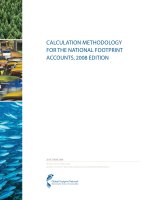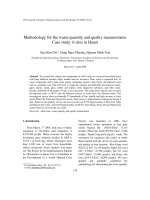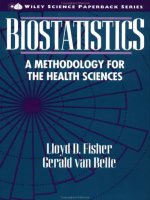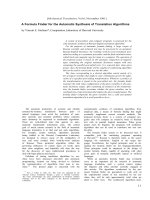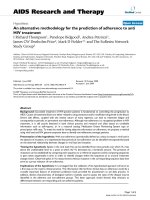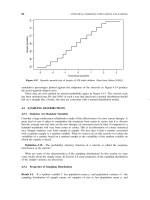development of methodology for the palladium-catalysed synthesis of oxygen-containing heterocycles
Bạn đang xem bản rút gọn của tài liệu. Xem và tải ngay bản đầy đủ của tài liệu tại đây (8.1 MB, 203 trang )
Glasgow Theses Service
Hewitt, Joanne F.M. (2014) Development of methodology for the
palladium-catalysed synthesis of oxygen-containing heterocycles. PhD
thesis.
Copyright and moral rights for this thesis are retained by the author
A copy can be downloaded for personal non-commercial research or
study, without prior permission or charge
This thesis cannot be reproduced or quoted extensively from without first
obtaining permission in writing from the Author
The content must not be changed in any way or sold commercially in any
format or medium without the formal permission of the Author
When referring to this work, full bibliographic details including the
author, title, awarding institution and date of the thesis must be given.
Development of Methodology for the
Palladium-Catalysed Synthesis of
Oxygen-Containing Heterocycles
Joanne F. M. Hewitt (M. Sci)
A thesis submitted in part fulfillment of the requirements of
the degree of Doctor of Philosophy
School of Chemistry
College of Science and Engineering
University of Glasgow
April 2014
2
Abstract
The opening chapter of this thesis gives an overview of the existing methods to
functionalise palladium(II)-alkyl intermediates resulting from oxy- or carbopalladation of
unactivated alkenes, outlining the range of heterocycles which can be formed using this
type of methodology. A summary of Pd(IV) species in synthesis and catalysis follows,
with a focus on Pd(IV) intermediates arising from oxidative addition of alkyl halides to
Pd(II) and those suggested in alkene difunctionalisation reactions.
As the subsequent formation of sp
3
–sp
3
C–C bonds from Pd(II)-alkyl intermediates was
noted as a limitation of prevailing nucleopalladation methods, the second chapter of this
thesis outlines the work towards development of an oxypalladation reaction of
hydroxyalkenes, with concomitant formation of an sp
3
–sp
3
C–C bond. Allyl halides proved
to be competent electrophiles for this transformation. The oxyallylation reaction was
successfully applied to a range of hydroxyalkene substrates, with the methodology
developed also applied to a 5-step synthesis of anti-depressant citalopram. The
oxyallylation reaction constructs heterocycles substituted in the 2-position, forming two
new bonds in a single step.
Ensuing work, detailed in Chapter 3, focused on the development of an analogous
carboallylation reaction, using aryl boronic acid derivatives. This transformation gives rise
to the formation of two new C–C bonds in a single step, including the construction of a
fully substituted carbon centre.
Experimental procedures and data are summarised in Chapter 4.
O
NC
N
F
Citalopram
OH
R
2
O
R
2
Pd(hfacac)
2
(cat.)
NaHCO
3
, toluene, 50 °C
X
R
1
R
1
>20 examples
O
Pd(hfacac)
2
(10 mol%),
Na
2
CO
3
, DME, 50 °C, 20 h
Cl
BF
3
K
O
3
Acknowledgements 5
Author’s Declaration 6
Abbreviations 7
1. Functionalisation of Alkenes: Synthesis of Oxygen Containing
Heterocycles 10
1.1 Introduction 10
1.2 Oxypalladation of Alkenes 12
1.2.1 Wacker-Type Cyclisations 12
1.2.2 Difunctionalisation via Wacker-Type Cyclisations 14
1.3 Carbopalladation of Alkenes 23
1.3.1 Carbocyclisation−β-hydride Elimination 23
1.3.2 Carbocyclisation–C–X Bond Formation 25
1.3.3 Carbocyclisation–C–C Bond Formation 26
1.4 Pd(IV) Chemistry 29
1.4.1 Pd(IV) Species from Oxidative Addition of Alkyl Halides 30
1.4.2 Pd(IV) Species from Stoichiometric Oxidants 33
1.5 Summary 36
2. Synthetic Approaches Towards Heterocyclisation of Unactivated Alkenes
37
2.1 Introduction and Aims 37
2.1.1 Mechanistic Rationale 38
2.1.2 Substrate Design and Synthesis 38
2.2 Attempted Pd(II)−Pd(IV) Catalysed Heterocyclisation 39
2.2.1 Attempted Heterocyclisation Using Bromoalcohol 39
2.2.2 Attempted Heterocyclisation Using Benzylic Alcohol 43
2.2.3 Attempted Heterocyclisation Using Phenol 49
2.3 Oxyallylation of Unactivated Alkenes 58
2.3.1 Oxyallylation Reaction Development 58
2.3.2 Substrate Scope: Phenols 63
2.3.3 Substrate Scope: Alcohols 69
2.3.4 Reaction Limitations: Oxyallylation of Monosubstituted Alkenes 96
2.3.5 Reaction Limitations: Nitrogen-Containing Substrates 101
2.4 Synthesis of Citalopram 109
2.4.1 Selected Literature Syntheses of Citalopram and Escitalopram 109
2.4.2 Synthesis of Citalopram via an Oxyallylation Reaction 112
2.5 Oxyallylation Reaction Mechanism 115
2.6 Conclusions 120
4
2.7 Future Work 121
3. Synthetic Approaches Towards Carbocyclisation of Unactivated Alkenes
122
3.1 Introduction and Aims 122
3.2 Synthesis and Reactions of Boronic Acid 123
3.3 Synthesis and Reactions of Boronic Acid Derivatives 133
3.3.1 Synthesis of Boronic Acid Derivatives 133
3.3.2 Reactions of Boronic Acid Derivatives 135
3.4 Conclusions 140
3.5 Future Work 141
4. Experimental 142
4.1 General Experimental Information 142
4.2 Experimental Details 143
5. References 196
5
Acknowledgements
I would like to extend my thanks to Dr. David France for giving me the opportunity to work
in (and launch!) his research group and for all his advice and support over the course of
my PhD.
I am also grateful to my second supervisor, Dr. Andrew Sutherland, and Dr. Joëlle Prunet
for their helpful thoughts and discussions on my research. I would like to express my
gratitude to the department staff, academic, technical and administrative, for their support.
Many thanks to the France boyz Lewis, Craig and David for their diligent thesis proof
reading efforts. I’d also like to thank all the France, Prunet and Marquez group members,
past and present, for some truly hilarious moments in the Raphael lab. Particular thanks
to Helen, Toni, Pooja, Mhairi and Anna for great chat and keeping the testosterone levels
in the lab slightly lower!
Outwith the department: for cocktails, mocktails, Sunday runs and endless cups of tea,
the experience wouldn’t have been quite the same without the witches Victoria, Leigh and
Laura and running buddy Michael. Writing up wouldn’t have been half as entertaining
without random chat, thesis avoidance and procrastination with Jonathan. For keeping me
sane by getting me away from chemistry to explore Scotland and beyond through running,
cycling and swimming (and eating good food and cake!), many thanks to Glasgow
Triathlon Club, especially the tri girls Hannah, Lexy, Christine, Elizabeth, Caroline and
Fiona.
I am appreciative of the endless support and encouragement from my family: my Mum,
sister Jennie, brother Iain and all the other Allan nutters.
Financial support from the University of Glasgow, WestCHEM and EPSRC is gratefully
acknowledged.
Finally, I’d like to thank Douglas Adams for giving me the answer to the great question of
life, the universe and everything.
6
Author’s Declaration
This thesis represents the original work of Joanne Frances Mary Hewitt unless otherwise
explicitly stated in the text. The research was carried out at the University of Glasgow in
the Raphael Laboratory under the supervision of Dr. David France during the period of
October 2010 to September 2013. Portions of the work described herein have been
published elsewhere, as below:
Hewitt, J. F. M.; Williams, L.; Aggarwal, P.; Smith, C. D.; France, D. J. Chem. Sci. 2013, 4,
3538–3543.
7
Abbreviations
Å angstrom(s)
Ac acetyl
acac acetylacetonate
aq. aqueous
Ar aryl
BBN borabicyclo[3.3.1]nonane
bipy bipyridine
Bn benzyl
Boc tert-butoxycarbonyl
BOXAX bis(oxazolyl)-binaphthyl
br broad
BRSM based on recovered starting material
BSA bis(trimethylsilyl)acetamide
Bu butyl
Bz benzoyl
°C degrees centigrade
cat. catalytic
CI chemical ionisation
conc. concentration/concentrated
COP cobaltocenyloxazoline palladacycle
COSY correlation spectroscopy
Cy cyclohexyl
d doublet
dba dibenzylideneacetone
DCE dichloroethane
DIBAL-H diisobutylaluminium hydride
DIPEA diisopropyl ethyl amine
dppf diphenylphosphorylferrocene
dppp diphenylphosphorylpropane
DME dimethoxyethane
DMF N,N-dimethylformamide
DMSO dimethylsulfoxide
dtbpy di-tert-butylpyridine
er enantiomeric ratio
EI electron impact
equiv equivalents
8
ESI electrospray ionisation
Et ethyl
Et
2
O diethyl ether
EtOAc ethyl acetate
EWG electron withdrawing group
FAB fast atom bombardment
FTIR Fourier transform infrared spectroscopy
g gram(s)
h hour(s)
hfacac hexafluoroacetylacetonate
HMBC heteronuclear multiple bond correlation
HPLC high performance liquid chromatography
HRMS high resolution mass spectrometry
HSQC heteronuclear single-quantum correlation
Hz hertz
IPA 2-propanol
IR infrared
J NMR spectra coupling constant
L ligand
LDA lithium diisopropylamide
M molar
m multiplet
mdtbpy 4-methyl-2,6-di-tert-butylpyridine
Me methyl
MeCN acetonitrile
MeOH methanol
mg milligram(s)
MHz megahertz
MIDA methyliminodiacetic acid
min minute(s)
mL millilitre(s)
mmHg millimetres mercury
mmol millimole(s)
mol mol(es)
MOM methoxymethyl
Ms methanesulfonyl
MS molecular sieves
m/z mass to charge ratio
NMR nuclear magnetic resonance
9
NBS N-bromosuccinimide
NMO N-methylmorpholine N-oxide
NMP N-methylpyrrolidinone
nOe nuclear Overhauser effect
NOESY nuclear Overhauser effect spectroscopy
Nu nucleophile
PBQ p-benzoquinone
PG protecting group
Ph phenyl
phen phenanthroline
ppm parts per million
iPr isopropyl
py pyridine
q quartet
quant. quantitative
s singlet
sat. saturated
SERT serotonin transporter
SET single electron transfer
sp sparteine
SPRIX spiro bis(isoxazoline)
SSRI selective serotonin reuptake inhibitor
R
f
retention factor
RT room temperature
t triplet
TBAF tetra-n-butylammonium fluoride
TBDPS tert-butyldiphenylsilyl
TBME tert-butyl methyl ether
TEMPO 2,2,6,6-tetramethylpiperidinyloxy
Temp temperature
TFA trifluoroacetic acid
THF tetrahydrofuran
TIPS-EBX triisopropylsilyl ethynylbenziodoxolone
TLC thin layer chromatography
Tf trifluoromethanesulfonyl
Ts 4-toluenesulfonyl
µL microlitre(s)
µw microwave
% wt. percentage by weight
10
1. Functionalisation of Alkenes: Synthesis of Oxygen
Containing Heterocycles
1.1 Introduction
Heterocyclic architectures are prevalent in natural products and are of particular interest
to synthetic and medicinal chemists due to their pharmacological and biological activities.
1
Five- and six-membered oxygen-containing heterocycles are amongst the most commonly
found moieties, with the tetrahydrofuran core found in natural product classes including
annonaceous acetogenins 1.1,
2
macrodiolides 1.2
3
and lignans 1.3
4
(Figure 1.1). To
synthesise heterocycles such as those shown in Figure 1.1, in addition to acid catalysed
cyclisations and ring closing metathesis,
5
many of these ring systems are constructed via
haloetherification of hydroxyalkenes of an appropriate chain length.
6
Although
haloetherifications result in the formation of a new C–X bond, which can be elaborated
through standard C–C bond formation techniques, methods that allow for ring closure with
concomitant formation of a new C–C bond are of great interest.
Figure 1.1: Natural products containing tetrahydrofuran architectures
Functionalisation of alkenes by transition metal catalysis is another method that has been
used to construct oxygen-containing heterocycles and, although there are examples
making use of Cu,
7
Ag,
8
Pt
9
and Au
10
catalysts, the majority of examples reported are
catalysed by palladium complexes.
11
Highlighting the significant impact that palladium
chemistry has made to the evolution of the chemists’ synthetic toolbox, the 2010 Nobel
Prize in chemistry was awarded to Richard F. Heck, Ei-ichi Negishi and Akira Suzuki in
recognition of their contribution. However, whilst the Heck, Negishi and Suzuki reactions
result in the construction of only one new C–C bond, many palladium-catalysed reactions
are cascade reactions,
12
giving rise to multiple new bonds in a single step. These
reactions allow rapid assembly of molecular complexity from comparatively simple starting
materials.
O
O
OH
OH
O
H
H
OH
1.1
acetogenin - annonacin
O
O
O
O
O
O
O
NMe
2
1.2
macrodiolide - pamamycin 607
5
O
O
O
MeO
MeO
MeO
1.3
lignan - burseran
9
11
In 1959, Wacker Chemie reported the development of an industrial scale palladium-
catalysed method for the aerobic oxidation of ethylene to acetaldehyde, where Pd(II)
could be regenerated by molecular oxygen in the presence of a copper co-catalyst
(Scheme 1.1).
13
Upon coordination of an alkene by Lewis acidic Pd(II), affording a
palladium complex such as 1.4 (Scheme 1.1), the traditional nucleophilicity of the alkene
is reversed, activating the alkene towards nucleophilic attack. This can proceed via attack
from an inner sphere coordinated water or hydroxide (cis-oxypalladation) or outer sphere
water or hydroxide (trans-oxypalladation) to form a Pd(II)-alkyl intermediate with a
β-hydroxyl group 1.5. β-hydride elimination affords vinyl alcohol, which tautomerises to
give acetaldehyde and Pd(0). The catalytic cycle is completed by Cu/O
2
re-oxidation of
Pd(0), produced by reductive elimination of HX from Pd(II). The Wacker reaction has been
the subject of considerable study and mechanistic debate since the original report,
primarily over whether the reaction proceeds via cis- or trans-oxypalladation.
14
Scheme 1.1: Catalytic cycle of Wacker process
Subsequent to the development of the Wacker process, it was reported that Pd(II) could
facilitate the addition of a number of different types of nucleophiles to alkenes, giving rise
to C−O, C−N and C−C bond formation under oxidative and non-oxidative conditions.
15
In
addition to intermolecular procedures, Wacker-type cyclisations have also been
developed, in which a palladium(II) complex activates an alkene with a tethered
nucleophile, such as 1.6 (Scheme 1.2) towards intramolecular nucleophilic attack. The
Pd(II)-alkyl intermediate 1.7 produced in these reactions readily undergoes β-hydride
elimination to afford heterocycles such as 1.8.
Scheme 1.2: Nucleopalladation–β-hydride elimination of 1.6
H
2
C
CH
2
+
1/2 O
2
Pd/Cu
H
O
Pd
II
Pd
0
Pd
II
OH
Pd
II
X
X
X
CH
2
H
2
C
H
O
H
2
O
HX
2Cu
2+
2Cu
+
1/2 O
2
+ 2H
+
H
2
O
H
OH
tautomerisation
1.4
1.5
HPd
II
X
HX
NuH
Nu
1.6
Nu = O, NR
Nu
Pd
II
X
2
1.7 1.8
Pd
II
X
– HX
12
1.2 Oxypalladation of Alkenes
1.2.1 Wacker-Type Cyclisations
Although a number of different nucleophiles can attack a Pd(II) coordinated alkene, the
first part of this review will focus on those forming C–O bonds. In 1973, Hosokawa and co-
workers reported the first intramolecular cyclisation of alcohol nucleophiles onto
unactivated alkenes (Scheme 1.3).
16
Oxypalladation of the sodium salt of o-allylphenol 1.9
with stoichiometric PdCl
2
(MeCN)
2
followed by β-hydride elimination and isomerisation to
the more thermodynamically stable alkene afforded 2-methylbenzofuran 1.10. Despite the
low yield, no starting material was recovered from this cyclisation, only polymeric residue.
Scheme 1.3: Wacker-type cyclisation of o-allyl phenol sodium salt 1.9
Hosokawa and co-workers subsequently reported that use of Pd(OAc)
2
as the Pd(II)
source allowed the phenols to be used directly (Scheme 1.4).
17
In the cyclisation of
disubstituted alkene 1.11, the authors observed that use of the acetate salt of palladium in
place of the chloride salt resulted in the formation of a 1:1 mixture of the direct β-hydride
elimination product 1.12 and the isomerised product 1.13. Resubjecting 1.12 to the
reaction conditions did not induce isomerisation to 1.13 so the difference in product
composition was concluded to be due to the alteration of Pd salt used. Furthermore,
carrying out the reaction under catalytic conditions using Cu(OAc)
2
−O
2
as the re-oxidant
afforded almost complete conversion of 1.11 to 1.12. These conditions could be applied to
the synthesis of a range of substituted benzofurans and dihydrobenzofurans.
Scheme 1.4: Wacker cyclisation of o-allyl phenol 1.11
In addition to the cyclisation of phenols, Wacker-type cyclisations have also been used in
the reactions of alcohols
18
and carboxylic acids.
19,20
As the terminating step of these
processes produces Pd(0), catalyst re-oxidation is an essential feature. Use of
copper/oxygen couples introduces a secondary catalytic cycle and use of oxidants such
ONa
O
PdCl
2
(MeCN)
2
(1 equiv),
NaOMe, benzene,
reflux, 3 h
31%
1.9 1.10
OH
O
Pd(OAc)
2
(2 mol%),
Cu(OAc)
2
•H
2
O (50 mol%),
MeOH/H
2
O (10:1),
O
2
, 55 °C, 24 h
O
+
1.13
trace
1.11 1.12
54%
13
as p-benzoquinone requires the removal of stoichiometric quantities of organic
compounds. Bäckvall et al.
21
and subsequently Stoltz and co-workers
22
developed
procedures utilising O
2
−coupled catalysis, which produce water or hydrogen peroxide as
the only re-oxidation by-product (Scheme 1.5). These procedures could be successfully
applied to both aliphatic alcohols and o-allylphenols.
Scheme 1.5: Aerobic Wacker-type cyclisations of alcohols 1.14 and 1.16
Although Hosokawa and co-workers were able to demonstrate low levels of
enantioselectivity in Wacker cyclisations using an [(η
3
-pinene)PdOAc]
2
catalyst system
(up to 63:37 e.r.),
23
the most effective catalyst systems have employed ligands based on
chelating nitrogen ligands (Scheme 1.6). Stoltz and co-workers found the natural product
(−)-sparteine 1.18 was the most effective at inducing asymmetry in the heterocyclisation of
1.16, with benzofuran 1.17 afforded in 87% yield and 91:9 e.r Hayashi et al. achieved
enantioselectivity of 98:2 e.r. in the cyclisation of 1.16 to afford 1.17 in 80% yield using
BOXAX ligand 1.19.
24
However, Zhang and co-workers developed a chelation-induced,
axially chiral tetraoxazoline ligand 1.20, which showed greater generality in the
asymmetric heterocyclisation of phenols onto tri-
25
or tetra
26
-substituted alkenes, affording
consistently high enantiomeric ratios.
Scheme 1.6: Enantioselective Wacker-type cyclisation of phenol 1.16
OH
Pd(OAc)
2
(5 mol%),
DMSO, O
2
, 23 °C, 24 h
O
H
H
90%
OH
O
Pd(TFA)
2
(5 mol%),
pyridine (20 mol%),
Na
2
CO
3
(2 equiv), MS3Å,
O
2
, toluene, 80 °C, 0.33 h
95%
1.14 1.15
1.16 1.17
1.18
(sp)Pd(TFA)
2
(10 mol%),
sparteine (100 mol%),
Ca(OH)
2
, MS 3Å,
toluene, O
2
, 80 °C, 36 h
87%, 91:9 e.r. (R)
N
N
1.20
PdTFA
2
(10 mol%),
1.20(10 mol%),
p-benzoquinone,
MeOH, 25 °C, 72 h
79%, 97:3 e.r. (S)
O
N
N
OO
N
N
O
Ph
Ph
Ph
Ph
OH
O
1.19
Pd(MeCN)
2
(BF
4
)
2
(10 mol%),
1.19 (30 mol%),
p-benzoquinone,
MeOH, 20 °C, 12 h
80%, 98:2 e.r. (S)
N
O
N
O
*
Pd
II
X
2
, ligand*
CO
2
Me
MeO
2
C
1.16 1.17
14
Many mechanistic studies have been carried out to investigate the stereochemistry of
oxypalladation; however, Hayashi and co-workers elegantly demonstrated that the
cyclisation of a single substrate could afford cis- or trans-oxypalladation, dependent on
the reaction conditions (Scheme 1.7).
27
Thus, using catalytic Pd(MeCN)
4
(BF
4
)
2
and
(S,S)-iPr-boxax ligand 1.27, cyclisation of 1.21 provided only products 1.22, 1.23, 1.24
and 1.25, consistent with cis-oxypalladation, as did cyclisation using Hosokawa’s
[(η
3
-pinene)PdOAc]
2
catalyst system. However, use of a PdCl
2
(MeCN)
2
catalyst with
added LiCl afforded predominantly 1.26, a product consistent with trans-oxypalladation.
Although it appears tempting to conclude that higher concentrations of chloride ions leads
to trans-nucleopalladation, other examples where cis-nucleopalladation occurs in the
presence of high chloride concentrations exist,
28
indicating that the identity of the
substrate can also directly affect the products afforded.
Scheme 1.7: Product distribution of Wacker-type cyclisations of alcohol 1.21
1.2.2 Difunctionalisation via Wacker-Type Cyclisations
C–O and sp
3
–sp
2
C–C Difunctionalisation
Oxypalladation−β-hydride elimination processes afford heterocycles that have undergone
functionalisation at one carbon of the alkene. In order to achieve difunctionalisation,
β-hydride elimination must be prevented. This can be achieved either by stabilisation of
the Pd(II)-alkyl intermediate, or by interception of the intermediate by a functionalisation
step that occurs at an increased rate with respect to β-hydride elimination. These
subsequent functionalisation steps can furnish a wide range of heterocyclic products
(Scheme 1.8) and will be discussed forthwith. Although the methods detailed herein focus
predominantly on those forming new C−C bonds, a variety of methods have been recently
OH
D
O O O
O
H H
D
D
D
Pd(MeCN)
4
(BF
4
)
2
(5 mol%), (S,S)-iPr-boxax 1.27 (10 mol%), p-benzoquinone, MeOH, 40 °C, 4 h, 78%
Bis[acetoxy(3,2,10-η
3
-pinene)palladium(II) (10 mol%), Cu(OAc)
2
(10 mol%), O
2
, MeOH, 65 °C, 82%
PdCl
2
MeCN
2
(10 mol%), p-benzoquinone, Na
2
CO
3
, LiCl, THF, 65 °C, 24 h, 59%
O
D
1.22
cis-oxypalladation
1.23
cis-oxypalladation
1.24
cis-oxypalladation
1.25
cis-oxypalladation
1.26
trans-oxypalladation
N
O
N
O
iPr
iPr
(S,S)-iPr-boxax 1.27
1.21
1.22
16
83
3
6
1.23
46
14
3
5
1.24
29
3
3
7
1.25
9
0
3
0
1.26
0
0
3
82
15
reported in which the Pd(II)-alkyl intermediate is intercepted oxidatively to subsequently
form new C−halogen,
29
C−O
30
and C−N bonds.
31
Scheme 1.8: Transformations of the Pd(II)-alkyl intermediate 1.29 produced by oxypalladation of 1.28
Under an atmosphere of carbon monoxide, the Pd(II)-alkyl intermediate formed from a
heterocyclisation step can undergo migratory insertion and subsequently be trapped using
alcohols to afford esters. This methodology was originally reported by Semmelhack and
co-workers in 1984 and was used in a stereoselective synthesis of the methyl ester of a
glandular secretion from the civet cat 1.38 (Scheme 1.9).
32
In addition to the synthesis of
1.38, the authors demonstrated that a range of substitution patterns could be tolerated in
the substrate. The formation of 6-membered rings was found to proceed in a highly
stereoselective fashion, affording the products as a single diastereomer.
Scheme 1.9: Synthesis of the methyl ester of civet cat secretion 1.38
This oxycarbonylation methodology was employed by the Tietze group as a key step in
the enantioselective total synthesis of (−)-diversonol 1.43 (Scheme 1.10).
33
Thus,
treatment of phenol 1.40 with catalytic Pd(TFA)
2
and (S,S)-Bn-boxax 1.41 under an
atmosphere of CO in methanol afforded chroman product 1.42 in 80% yield and 98:2 e.r
Here, p-benzoquinone was used re-oxidise Pd(0) back to Pd(II). A further 13 steps
facilitated the transformation of chroman 1.42 into (−)-diversonol 1.43.
OH
O
O
O
O
O
EWG
OR
O
Ar
O
OAc
O
R
1
O
SiR
3
CO,
ROH
EWG
Pd
II
X
2
= Pd
II
XR
1
R
1
= Ar, CH=CHR
2
,
C CR
2
ArH
PhI(OAc)
2
β-hydride
elimination
1.28
1.29
1.30 1.31
1.32
1.33
1.34
1.351.36
Pd
II
X
2
Pd
II
X
SiR
3
I
III
– HX
OH
O
CO
2
Me
H H
O
CO
2
Me
H H
+
PdCl
2
(10 mol%),
CuCl
2
(3 equiv),
MeOH, CO, RT, 17 h
74%
1.37 1.38 1.39
20:1 d.r.
16
Scheme 1.10: Enantioselective oxycarbonylation of 1.40 in total synthesis of (–)-diversonol 1.43
In addition to carbonylation, the Pd(II)-alkyl intermediate can also undergo
carbopalladation onto an exogeneous alkene. By employing substrates which were
geminally disubstituted on the alkene, Semmelhack and co-workers reported that Pd(II)
intermediate 1.45, formed from heterocyclisation of hydroxyalkene 1.44, could be
intercepted by Heck acceptors such as methyl acrylate, methyl vinyl ketone and styrene to
afford heterocycles 1.46 (Scheme 1.11).
34
The reaction was only successful for
electronically biased olefins – no detectable oxyvinylation products were obtained where
hexene or cyclohexene were employed, with the alcohols recovered in good yield.
Importantly, this observation suggests that the formation of palladium intermediate 1.45 is
reversible under the reaction conditions. Although these reactions were stoichiometric in
palladium, catalysis of the heterocyclisation of alcohol 1.47 was successful when a
CuCl–O
2
re-oxidation system was employed to afford product 1.48 in 89% yield (Scheme
1.11).
Scheme 1.11: Oxyvinylation of disubstituted alkenes 1.44 and 1.47
In order to probe whether monosubstituted alkenes could be tolerated in the oxyvinylation
reaction, hydroxyalkene 1.49 was reacted under identical conditions to those shown in
Scheme 1.11; however, desired product 1.51 was not afforded, with only ketone 1.53
afforded (Scheme 1.12). The authors proposed this product was formed by oxypalladation
N
O
N
O
Bn
Bn
1.41
(S,S)-Bn-boxax
OMe
OH
O
OMe
OMe
O
Pd(TFA)
2
(3 mol%),
(S,S)-Bn-boxax 1.41 (12 mol%),
p-benzoquinone,
CO, MeOH, RT, 15 h
80%, 98:2 e.r.
O
OH O
OH
OH
OH
1.43
(–)-diversonol
1.40 1.42
13 steps
OH
R
O
R
R
1
R
1
Pd(OAc)
2
(1–1.25 equiv),
DMF, RT, 5 min to 6 h
NaOAc or NaHCO
3
(2 equiv),
with/out NaI (0.2 equiv)
1.46
R = H or iBu
R
1
= COMe, CO
2
Me or Ph
86–91%
OH
O
Pd(OAc)
2
(10 mol%),
CuCl (1 equiv), O
2
, RT, 2 h
89%, 1:1 d.r.
O
O
O
R
Pd
II
X
1.44
1.45
1.47
1.48
17
of 1.49 to afford Pd(II)-alkyl intermediate 1.50, which could then undergo β-hydride
elimination to afford 1.52 followed by hydrolysis under the work-up procedure to give
observed product 1.53. Thus, unlike the carbonylation example (Scheme 1.9), the rate of
carbopalladation of the Pd(II)-alkyl intermediate 1.50 with the alkene is not sufficiently fast
to compete with the rate of β-hydride elimination, thus the substrates must be designed
such that β-hydride elimination is not a possibility.
Scheme 1.12: Attempted oxyvinylation of monosubstituted alkene 1.49
Tietze and co-workers were able to extend this oxyvinylation methodology to an
enantioselective synthesis of α-tocopherol, one of the components of vitamin E (Scheme
1.13).
35
Cyclisation of phenol 1.54 using catalytic Pd(TFA)
2
and (S,S)-Bn-Boxax ligand
1.41 afforded chroman 1.55. The highest enantioselectivity (98:2 e.r.) was obtained where
the spectator hydroxyl group was protected by a benzyl group and the alkene trap was
methyl vinyl ketone. Further elaboration of this intermediate afforded α-tocopherol as a
mixture of epimers at the 4´ position.
36
Scheme 1.13: Enantioselective oxyvinylation reaction of 1.54 in synthesis of α-tocopherol 1.56
The methodology detailed thus far has made use of Pd(II) salts and relied on subsequent
interception of the Pd(II)-alkyl intermediate. Wolfe and co-workers made use of a Pd(0)
catalyst source and aryl or alkenyl halides to produce Pd(II) sources in situ. These
OH
O
Pd(OAc)
2
(1 equiv),
NaHCO
3
, DMF,
RT, 1.5 h
O
O
1.51
not observed
OH
O
1.53
80%
O
H
Pd
II
X
O
1.49 1.50
1.52
BnO
OH O
BnO
PdTFA
2
(10 mol%),
(S,S)-Bn-boxax 1.41 (40 mol%),
p-benzoquinone (4 equiv),
CH
2
Cl
2
, 84 h
84%, 98:2 e.r.
O
R
1
O
HO
4'4'
O
1.54 1.55
1.56
18
catalysts were able to effect the oxyarylation or oxyalkenylation of γ-hydroxyalkenes to
afford substituted tetrahydrofurans (Scheme 1.14).
37
In contrast to the methodology
developed by the groups of Semmelhack and Tietze, monosubstituted alkenes were not
only tolerated in these reactions, but performed better. Thus, oxyarylation of 4-pentenol
(R
1
= R
2
= H) with 4-bromotoluene afforded a 65% yield of tetrahydrofuran 1.59 whereas
the disubstituted alkene (R
1
= H, R
2
= Me) gave only 19% yield of 1.60. Tertiary alcohol
1.57 (R
1
= R
2
= Me) proved unreactive even when heated to 140 °C in xylenes. During the
reaction development, the authors found that use of a chelating bis(phosphine) ligand was
essential to suppress competing reduction of the aryl halide.
38
Another common side
reaction was the formation of ethers from O-arylation or O–vinylation. The formation of
these side products was most problematic when primary alcohol substrates were
employed, hence 1.62 was formed in only 32% yield from 4-pentenol 1.57 (R
1
= R
2
= H)
whereas tertiary alcohol 1.57 (R
1
= Me, R
2
= H) gave an 81% yield of 1.63.
Scheme 1.14: Carboetherification of alkenes 1.57
Despite the range of substrates successfully cyclised under the developed conditions,
Wolfe and co-workers were unable to effect the formation of 6-membered heterocycles
under the optimised conditions. The reaction scope was also limited to aliphatic alcohols
where, under the optimised conditions, the attempted cyclisation of o-allylphenol 1.64
gave rise to only isomerisation of the alkene to afford 1.65, with desired product 1.66 not
observed (Scheme 1.15).
39
Scheme 1.15: Attempted carboetherification of o-allyl phenol 1.64
In order to address these limitations, the authors chose to analyse the reaction of phenol
1.67 (n = 1), as this substrate was expected to be less disposed to alkene isomerisation
HO
R
2
R
1
R
1
Pd
2
dba
3
(1 mol%),
DPE-Phos (2 mol%),
R
3
-Br (2 equiv)
NaOtBu (2 equiv), THF, 65 °C
O
R
3
R
2
R
1
R
1
O O O
1.59
65%
1.60
19%
1.61
not formed
O
1.62
32%
Ph
O
Ph
1.63
81%
1.57
1.58
Pd
2
dba
3
(2 mol%),
DPE-Phos (4 mol%),
NaOtBu, PhBr,
THF, 65 °C
OH
O
OH
1.66
not observed
1.64 1.65
Ph
19
(Scheme 1.16). Pleasingly, simple alteration of the phosphine ligand from bidentate
ligand DPE-Phos to monodentate ligand S-Phos 1.68, which had shown success in other
difficult cyclisation reactions,
40
afforded desired product 1.70 in 75% isolated yield. In
contrast to the reactions of linear aliphatic alcohols, the cyclisations of substrates bearing
geminally disubstituted alkenes provided synthetically useful yields of chroman
heterocycles 1.71 and 1.72. Substrates with internal alkenes failed to undergo the desired
carboetherification reaction, even at temperatures of 140 °C. In addition, although
chroman products could be prepared effectively using these modified conditions,
benzofuran products remained challenging; 1.73 was formed in only 37% isolated yield.
Scheme 1.16: Carboetherifiation of alkenes 1.67
The Stephenson group reported an oxidative alkene difunctionalisation, proposed to
proceed via a Pd(II)−Pd(IV) cycle, using PhI(OAc)
2
as a stoichiometric oxidant (Scheme
1.17). The reaction predominantly employed electron rich or neutral arenes with pendant
carboxylic acid groups to afford lactones.
41
Although the cyclisation of primary alcohol
1.75 was demonstrated, tetrahydrofuran 1.77 was isolated in only 46% yield, whereas the
corresponding lactone 1.76 was formed in 92% yield.
Scheme 1.17: Oxidative alkene difunctionalisation of 1.74 and 1.75 using PhI(OAc)
2
Subsequent to this publication, Buchwald et al. reported an oxidative functionalisation of
arylhydroxyalkenes 1.78 proceeding via oxypalladation−CH functionalisation, affording
tricyclic compounds 1.79 in high yields (Scheme 1.18).
42
Oxygen proved to be the most
effective oxidant for the desired reaction, with little to no conversion observed using
Pd(II)/Cu(II), Pd(II)/Ag(I) or Pd(II)/PhI(OAc)
2
combinations. In contrast to the reaction
developed by Stephenson and co-workers, the reaction tolerated electron donating and
Pd
2
dba
3
(2 mol%),
S-Phos 1.68 (4 mol%),
NaOtBu (2 equiv),
ArBr (2 equiv), THF, 110 °C
OH
O
Ar
O
C
6
H
4
COPh
O
O
Ph
n
1.67
n = 0, 1
n
1.69
n = 0, 1
R
R
1.70
75%
O
C
6
H
4
tBu
Ph
1.73
37%
1.71
71%
1.72
56%
MeO OMe
PCy
2
1.68
S-Phos
Ph
Pd(OAc)
2
(10 mol%),
PhI(OAc)
2
MeCN, RT, 12 h
X
O
H
X
OH
OMe
MeO
MeO
MeO
1.74 X = C=O
1.75 X = CH
2
1.76 X = C=O, 92%, 1.8:1 d.r.
1.77 X = CH
2
, 46%, >20:1 d.r.
20
withdrawing groups on the aromatic ring, in addition to a pyridyl group, which was
functionalised regioselectively to afford 1.83.
Scheme 1.18: Oxidative functionalisation of arylhydroxyalkenes 1.78
Buchwald effectively demonstrated the orthogonality of oxidative palladium(II) chemistry
with Pd(0) reactions, illustrated through the reactions of 1.84 (Scheme 1.19): a) under the
conditions described in the manuscript, 1.84 undergoes oxypalladation−C–H activation to
afford 1.85 with the aryl chloride still intact and no dechlorinated side products observed;
b) chroman 1.87 is formed under Pd(0)-catalysed C–O bond forming conditions; c) finally,
under carboetherification conditions similar to those developed by Wolfe and co-workers,
the alkene undergoes an oxyarylation reaction with the aryl chloride to afford 1.88. This
also demonstrates the versatility of palladium chemistry – that one starting material, under
slightly modified conditions, can give rise to three different products.
Scheme 1.19: Orthogonality of Pd(II) catalysis with Pd(0) catalysis
C–O and sp
3
–sp C–C Difunctionalisation
The methodology detailed thus far has demonstrated the variety of ways in which an
alkene can be difunctionalised through Wacker-type cyclisations to give rise to a new C–O
and C–C bond. However these examples all result in the formation of a new
Pd(OAc)
2
(5 mol%),
ethyl nicotinate (6 mol%)
K
2
CO
3
, toluene, O
2
,
100 °C, 19 h
O
OH
H
1.80
81%
X
X
R
R
O
H
O
H
O
H
O
H
N
O
2
N
MeO
1.81
80%
1.82
69%
1.83
73%
1.78 1.79
Pd(OAc)
2
(5 mol%),
ethyl nicotinate (6 mol%)
K
2
CO
3
, toluene, O
2
,
100 °C, 19 h
O
OH
H
Cl
Cl
Pd(OAc)
2
(2 mol%),
XPhos 1.86 (4 mol%),
K
2
CO
3
, toluene, 90 °C
O
Pd(OAc)
2
(2 mol%),
XPhos 1.86 (4 mol%),
NaOtBu, toluene, 90 °C
O
H
1.87
88%
1.88
50%
1.84
1.85
78%
iPr iPr
PCy
2
1.86
XPhos
iPr
21
C–C bond between an sp
3
-hybridised and an sp
2
-hybridised carbon. In 2010, Waser and
co-workers reported that triisopropylsilyl ethynylbenziodoxolone (TIPS-EBX) reagent 1.90
could be used to effect the palladium-catalysed oxyalkynylation of unactivated alkenes
1.89 (Scheme 1.20).
43
These reactions afforded generally excellent yields of
heterocyclised products, although only 34% of desired product 1.91 was obtained where
the aryl ring was substituted with a methyl group para to the hydroxyl group. Substrates
containing more electron donating substituents than a methyl group did not provide any of
the desired product. Although monosubstituted alkene substrate 1.64 could be
heterocyclised to afford desired product 1.92, the yield was moderate (Scheme 1.20).
Complete consumption of starting material 1.64 was observed; however, no side products
were formed in sufficient quantity to be isolated and characterised.
Scheme 1.20: Oxyalkynylation of unactivated alkenes 1.89 and 1.64
The oxyalkynylation reaction using TIPS-EBX could also be applied to the
heterocyclisation of benzoic acids to afford lactones (Scheme 1.21). In contrast to the
reactions of the phenol substrates, electron rich aryl substitution could be tolerated. In
addition to the increased tolerance of aryl substitution, whilst the oxyalkynylation of
aliphatic alcohols had proven unsuccessful, aliphatic acids could be employed to afford
the desired oxyalkynylation products. The oxyalkynylation of 1.95 to afford lactone 1.96
also demonstrates that monosubstituted alkenes can be tolerated in the reaction of
carboxylic acids (Scheme 1.21).
OH
Pd(hfacac)
2
(10 mol%),
CH
2
Cl
2
,
RT, 12 h
1.91
34–87%
O
SiiPr
3
I
O
O
SiiPr
3
R
R
R = H, Me, Br,
CN, NO
2
, Ac
1.89
1.90
OH
Pd(hfacac)
2
(10 mol%),
CH
2
Cl
2
,
RT, 12 h
43%
O
SiiPr
3
1.64 1.92
1.90
22
Scheme 1.21: Oxyalkynylation of carboxylic acids 1.93 and 1.95
A major limitation of the chemistry developed by Waser and co-workers was its inability to
allow access to tetrahydrofuran derivatives; under the standard conditions, cyclisation of
4-pentenol 1.28 afforded less than 25% of desired product 1.97 (Scheme 1.22). However,
by recourse to Wolfe-type conditions, using a Pd(0) catalyst and a silyl-protected
bromoacetylene, Waser et al. were able to afford tetrahydrofuran adduct 1.97 from
cyclisation of 4-pentenol 1.28 in 92% yield.
44
A variety of substitution patterns could be
tolerated in the oxyalkynylation reaction, including the cyclisation of secondary alcohols to
give 2,5-disubstituted tetrahydrofuran products in good to excellent diastereoselectivities
(5.7:1 – 19:1 d.r.). By a slight modification of the reaction conditions – use of Pd(dba)
2
in
place of Pd
2
dba
3
and reduction of the Pd/ligand ratio – Waser et al. were able to extend
this methodology to the use of bromoacetylenes substituted with aliphatic groups to afford
products such as 1.98.
45
Scheme 1.22: Pd(0)–Pd(II) catalysed oxyalkynylation of aliphatic alcohol 1.28
To summarise, the oxypalladation of alkenes to afford oxygen-containing heterocycles is a
well-studied area of research that has seen a recent revitalisation of interest. In addition to
the development of asymmetric examples of Wacker-type cyclisations, the contributions of
CO
2
H
Pd(hfacac)
2
(10 mol%),
CH
2
Cl
2
,
RT, 12 h
83%
O
I
O
O
SiiPr
3
O
SiiPr
3
CO
2
H
Pd(hfacac)
2
(10 mol%),
CH
2
Cl
2
,
RT, 3 h
82%
O
I
O
O
SiiPr
3
H
O
H
SiiPr
3
1.93 1.94
1.95 1.96
1.90
1.90
OH
Pd(hfacac)
2
(10 mol%),
CH
2
Cl
2
,
RT, 12 h
O
SiiPr
3
I
O
O
SiiPr
3
Pd
2
dba
3
(2 mol%),
DPE-Phos (4 mol%),
NaOtBu, toluene,
65–70 °C, 3 h
O
SiiPr
3
Br
SiiPr
3
(1.3 equiv)
1.97
92%
1.97
<25%
OH
Pd(dba)
2
(5 mol%),
DPE-Phos (7.5 mol%),
NaOtBu, toluene,
80 °C, 3 h
Br
C
6
H
13
(1.3 equiv)
69%
O
C
6
H
13
1.28
1.28 1.98
1.90
23
the Wolfe and Waser groups has seen an expansion in the scope of the C–C bond
formation capabilities of these reactions. However, it remains a challenge to construct a
new sp
3
–sp
3
C–C bond from the Pd(II)-alkyl intermediate (Scheme 1.23) and, as many of
the oxygen-containing heterocycles found in natural products and biologically active
compounds are substituted with saturated alkyl chains, this would be an attractive
prospect.
Scheme 1.23: Heterocyclisation of 1.28 with construction of new sp
3
–sp
3
C–C bond
1.3 Carbopalladation of Alkenes
In addition to facilitating the addition of oxygen nucleophiles to alkenes, as in the
heterocyclisation reactions described in Section 1.2, palladium(II) can also facilitate the
addition of carbon nucleophiles to alkenes. However, the problem associated with the
development of these reactions is the readiness with which carbanions are oxidised to
carbon radicals and so less reactive or masked carbanions must often be used. Many
examples of carbocyclisation reactions give rise to the formation of all-carbon rings;
however, this type of chemistry can also be used to access heterocycles via Pd(II)-
catalysed carbopalladation of alkenes containing a heteroatom tether 1.100 (Scheme
1.24).
46
The resulting Pd(II) species 1.101 can then undergo β-hydride elimination, or
further functionalisation to afford heterocycles 1.102 and 1.103 (Scheme 1.24).
Scheme 1.24: Pathways for carbocyclised intermediate 1.101
1.3.1 Carbocyclisation−β-hydride Elimination
Many methods of constructing heterocycles through carbopalladation are initiated via
oxidative addition of Pd(0) to an aryl or vinyl halide.
47
Larock and Stinn found that aryl
iodides possessing an ortho O-allyl group 1.104 could be successfully cyclised using
OH
O
O
Pd
II
X
R
H H
1.28 1.29 1.99
Pd
II
X
2
– HX
RCH
2
X
O
O
O
Pd
II
X
R
2
Pd
II
X
R
1
R
1
R
1
O
R
1
β-hyride
elimination
functionalisation
1.100 1.101
1.102
1.103
24
Pd(OAc)
2
, Na
2
CO
3
, nBu
4
Cl and sodium formate in DMF to afford benzofurans 1.105
(Scheme 1.25).
48
These conditions were similar to those developed for the analogous
anilines,
49
however, the addition of one equivalent of sodium formate was found to be
beneficial. This was proposed to be due to the reduction of π-allyl Pd(II) side product
1.107, and so keeping the Pd(0) catalyst active. Consistent with this suggestion, allyl
groups with a lower degree of substitution and better aryl leaving groups afforded lower
yields.
Scheme 1.25: Pd-catalysed synthesis of benzofurans 1.105 from aryl iodides 1.104
Stoltz and co-workers developed an oxidative synthesis of benzofuran and
dihydrobenzofuran derivatives, proceeding via direct C–H bond functionalisation of arenes
followed by cyclisation onto unactivated alkenes (Scheme 1.26).
50
Although O
2
was a
competent oxidant for this transformation, yields were higher using p-benzoquinone.
Thus, treatment of O-aryl ether 1.108 with catalytic Pd(OAc)
2
, ethyl nicotinate, NaOAc and
p-benzoquinone afforded the corresponding benzofuran 1.109. Quaternary carbon-
containing dihydrobenzofuran 1.111 could also be successfully synthesised using tetra-
substituted alkene 1.110, where alkene isomerisation is not possible in this product. This
chemistry was limited to the cyclisation of highly electron rich arenes and the synthesis of
five-membered oxygen heterocycles.
Scheme 1.26: Oxidative CH functionalisation–carbopalladation of alkenes 1.108 and 1.110
In 2007, Akiyama and Mikami reported an oxidative intramolecular cyclisation of boronic
acids to afford heterocycles (Scheme 1.27). Although products could be formed in
moderate yields using Pd
2
dba
3
and chiral ligand (S,S)-chiraphos 1.113, often mixtures of
oxidative 1.117 and non-oxidative 1.118 products were obtained and the scope of this
I
O
R
2
R
1
Pd(OAc)
2
(5 mol%),
Na
2
CO
3
(2.5 equiv), NaO
2
CH (1 equiv),
nBu
4
Cl (1 equiv), DMF, 80 °C, 48 h
6 examples, 40−83%
O
R
1
R
2
1.105
H
2
C CHCH
2
OAr
+ Pd
0
η
3
-C
3
H
7
Pd
II
OAr
1.104
1.106 1.107
Pd(OAc)
2
(10 mol%), ethyl nicotinate (20 mol%),
NaOAc (20 mol%), p-benzoquinone (1 equiv),
t-amyl alcohol:AcOH 4:1, 100 °C, 12 h
O
MeO
OMe
74%
OMeO
OMe
Pd(OAc)
2
(10 mol%), ethyl nicotinate (20 mol%),
NaOAc (20 mol%), p-benzoquinone (1 equiv),
t-amyl alcohol:AcOH 4:1, 100 °C, 12 h
O
MeO
OMe
71%
OMeO
OMe
1.108 1.109
1.110 1.111
